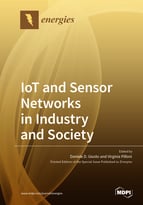IoT and Sensor Networks in Industry and Society
A special issue of Energies (ISSN 1996-1073). This special issue belongs to the section "A1: Smart Grids and Microgrids".
Deadline for manuscript submissions: closed (20 August 2020) | Viewed by 50527
Special Issue Editors
Interests: communication systems; sensor networks and IoT; smart cities and smart living; digital media
Special Issues, Collections and Topics in MDPI journals
Interests: Internet of Things; ad hoc networks; efficient resource allocation; smart buildings; crowdsensing/crowdsourcing
Special Issues, Collections and Topics in MDPI journals
Special Issue Information
Dear Colleagues,
We invite submissions to a Special Issue of Energies on the subject of “IoT and Sensor Networks in Industry and Society”. In the last decade, the deployment of IoT and sensor networks have made a strong impact on many aspects of society. The seamless integration of technologies to perform sensor data generation, transmission, and processing have enabled the development of smart solutions such as Smart Cities, Smart Agriculture, and Smart Transports. As the business environment is being increasingly digitized, traditional industrial processes are rapidly reshaping to build the fourth industrial revolution, namely Industry 4.0. This will pave the way for the use of ICT as the foundations of Society 5.0, a super smart human-centric society in which both economic development and resolution of societal challenges are achieved.
This Special Issue encourages high-quality unpublished contributions on recent advances in IoT and sensor networks towards the implementation of Industry 4.0 and Society 5.0. Topics of interest for publication include but are not limited to:
- Human-centric society and quality of life improvement;
- Artificial intelligence and robots for healthcare and ambient assisted living;
- ICT for infrastructure inspection and maintenance;
- Modeling, planning, and operating industrial processes in smart manufacturing;
- IoT data analysis for smart agriculture;
- Big data analytics and social media mining;
- Safe and secured society in both cyber and physical spaces;
- Smart retail and sales management;
- Connected and autonomous vehicles;
- IoT and sensor networks for environmental monitoring.
Prof. Dr. Daniele Giusto
Prof. Dr. Virginia Pilloni
Guest Editors
Manuscript Submission Information
Manuscripts should be submitted online at www.mdpi.com by registering and logging in to this website. Once you are registered, click here to go to the submission form. Manuscripts can be submitted until the deadline. All submissions that pass pre-check are peer-reviewed. Accepted papers will be published continuously in the journal (as soon as accepted) and will be listed together on the special issue website. Research articles, review articles as well as short communications are invited. For planned papers, a title and short abstract (about 100 words) can be sent to the Editorial Office for announcement on this website.
Submitted manuscripts should not have been published previously, nor be under consideration for publication elsewhere (except conference proceedings papers). All manuscripts are thoroughly refereed through a single-blind peer-review process. A guide for authors and other relevant information for submission of manuscripts is available on the Instructions for Authors page. Energies is an international peer-reviewed open access semimonthly journal published by MDPI.
Please visit the Instructions for Authors page before submitting a manuscript. The Article Processing Charge (APC) for publication in this open access journal is 2600 CHF (Swiss Francs). Submitted papers should be well formatted and use good English. Authors may use MDPI's English editing service prior to publication or during author revisions.
Keywords
- Industry 4.0
- Society 5.0
- Internet of Things
- Sensor networks
- Artificial intelligence
- Big data
- Smart city
- Robotics
- Human-centric society







